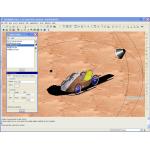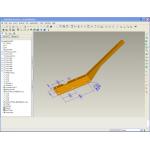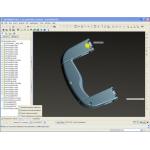Latest News
May 1, 2006
By Al Dean
Space is short, so let’s jump right into the enhancements and additions PTC made to version 3 of Pro/Engineer Wildfire.
As ever, a good place to start is one dear to every user—sketching, specifically, those used as the base for 3D features. Wildfire 3 can now handle more complex sketches (“complex” in PTC talk means 80+ entities), allowing the creation and more efficient regeneration of complex logos and such. Also sketching related is the new Feature Palette, which allows quick creation, storage, and reuse of commonly used sketch profiles, which can be dragged/dropped, scaled, rotated, moved from a discreet dialog. Finally for sketching, you can now use True Type fonts and have more control over how text is positioned and formatted (such as justification and so forth)—even have it follow a spline.
General Modeling Tools
Wildfire 3 offers a number of updates that are applicable to almost every Pro/Engineer user. The materials definition has been consolidated so that a single dialog is used to define a part’s properties for mechanical strength and behavior (for mass-related calculations and analysis), thermal, and sheet-metal properties (such as K factors and bend radii). The same dialog is also used to define that materials’ aesthetic properties, both in terms of color when modeling or when rendering (see Figure 1, below).
|
|
| Pro/Engineer Wildfire 3 from PTC. |
› › Figure 1: Wildfire 3’s rendering has been improved with the addition of some well-developed scenes that can be dropped into your product model to quickly create a realistic background for a render. The lighting set-up process has also been made much more dynamic and, as a result, is much easier to use. Also, consolidation of the Materials library means that you can define a part’s material not only in terms of mechanical behavior but also aesthetics in one single dialog.
On the subject of rendering, the manner in which you define scenes for a product model is now much easier. Lights are edited dynamically, and Wildfire is now supplied with a range of presets that will get you half way there; you just fiddle with the lights and the texture maps to achieve the results you want.
On the geometry creation and modification side, PTC updated the Warp tools introduced in the last two releases to allow you to work with geometry in a more freeform manner. This release sees greater control over the global operations (such as twist) to allow you to limit their range of influence and lock down the portions of a model. Finally, the patterning tools introduced over the last two releases see more work to afford the user greater control the creation of very complex arrays of features.
In addition to the preexisting directional and radial patterns, you can now create fill patterns—defined as direction, by square, diamond, or spiral—and exert much greater control over how they’re constructed. If you’ve based a pattern on surface, you can build the pattern either normal to the surface or to a specified direction. As well, you can define an offset boundary from an edge or curve so that you get the instances exactly where you need them (see Figure 2, below).
|
|
| Pro/Engineer Wildfire 3 from PTC. |
‹ ‹ Figure 2: Patterning is one of Pro/Engineer Wildfire’s strong points and this releases sees new tools that allow you to pattern on a surface with greater control and an expanded set of options for pattern building.
Last for general modeling, the new Swept Blend operation lets you create a complex transition between two profiles or surface edges using a single feature—this traditionally would have taken you several different steps (see Figure 3, below). Built using the Dashboard workflow-based approach, the system offers you a wide range of controls over all the variables and parameters.
|
|
| Pro/Engineer Wildfire 3 from PTC. |
› › Figure 3: Swept Blend allows you to create a complex transition between two profiles or surface edges using a single feature.
Sheet Metal
While the transition to Wildfire UI (user interface) is not complete, the good news is that Sheet Metal functions have been brought inline. Alongside the adaptation of the UI, Sheet Metal has been overhauled to make the process fit in with Pro/Engineer’s new way of working. What this means is that there are far fewer operations, with all options and variables built into a single Dashboard command. Further, it allows you to get sheet-metal forms built without a great deal of hassle.
Elsewhere, Wildfire 3 has tools that allow you to work much smarter when defining multiple flanges. You simply select multiple edges (or if required, tangent chains) and the system will build the flanges, providing you with options for end and edge treatments. If you use the tangent edges, you also have a great deal of control over how the corners seams are created.
Drafting and Annotation
As ever, drafting has seen attention. First, Pro/Engineer now includes Adobe PDF output of drawings as standard, using the native Adobe libraries. For those looking to automate the tedious part of the annotation process, drawing templates now allow you to automatically scale views to within the bounding box for each view, making automated drawing creation much more efficient. Also on the subject of drawing views, you can now have fully shaded views in your drawing sheets, which can assist with data presentation and clarity, particularly for complex assemblies and such (see Figure 4, below).
|
|
| Pro/Engineer Wildfire 3 from PTC. |
‹ ‹ Figure 4: Drawing views can be shaded to make presentation of complex data much less ambiguous than simply using standard geometry.
Wildfire 3 also sees more work done on what PTC refers to as 3D drawings (see Figure 5, below). Essentially, Wildfire 3.0 sees greater support added for ASME’s Y14.41-2003 standard which details how CAD systems should support the annotation of a 3D model directly, using standard GD and T methods, but within a 3D realm.
Finally on the drafting front, the new Quick Print feature is pretty handy. It allows you to take your current 3D product model and get a quick, basic drawing without futzing around with drawing sheets. The Quick Print option Works by bringing up a dialog where you simply select the drawing views you want and have the system print a basic drawing. You do not need to add them to a drawing sheet; it just prints the views—very quickly.
|
|
| Pro/Engineer Wildfire 3 from PTC. |
› › Figure 5: Wildfire’s 3D Drawings allow you to fully document a 3D model using the annotation tools and methods you’re used to in a 2D realm.
Assembly Modeling
While Pro/Engineer has always been more than capable of working with large assembly data, this release sees some work that extends its usefulness further. In the first instance, component interfaces have been reworked, allowing you to create nested interfaces (referred to as Smart Parts). This makes placement of components much more efficient, particularly when you’re placing more than one instance (see Figure 6, below).
|
|
| Pro/Engineer Wildfire 3 from PTC. |
‹ ‹ Figure 6: Assemblies have seen a lot of work in Wildfire 3, from how the system handles loading (using multithreading), through to tools to make assembly of components much less repetitive and more intelligent.
Mechanism verification tools have also been added within the core assembly modeling functionality, rather than requiring the Pro/Mechanism module. Mechanism properties, such as motion limits, are defined during the assembly process and the tools allow you to try out assemblies using kinematics and physics simulation technology—including collision detection and simulated contact (see Figure 7, below).
|
|
| Pro/Engineer Wildfire 3 from PTC. |
› › Figure 7: Wildfire 3’s assembly modeling tools now allow you to perform basic kinematic analysis of a mechanism in the core product, including dynamic collision detection, which includes physics simulations that allow you to push components with others.
Conclusions
Simply put, Pro/Engineer Wildfire 3 has been a long time coming; PTC’s release cycle seems to have slipped from 12 to 18 months, although the company did release beta versions of the software about a year ago. Still, for users paying for software on maintenance basis to not get a single major release within a calendar year, this is quite galling.
That said, the lengthier release cycle should mean a higher-quality product when shipped and a wider range of deliverables in each release. While product quality cannot be gauged yet, Pro/Engineer Wildfire 3 certainly offers a wide range of new tools that can be implemented immediately into each users’ workflow and make them more productive. These can be split into two camps, those that allow the user to do things they couldn’t before or to make an existing workflow more efficient. As with many software systems, today’s developments are firmly in the latter camp; evolution, rather than revolution.
Aside from the new Patterning and the Warp tools, the majority of Wildfire 3’s enhancements target existing workflows and improving them. Examples include the new Swept Blend operation, the assembly component interface nesting, and the updates to materials and rendering, all of which work to improve your working day. Of course, the other major force driving Pro/Engineer’s recent developments is the transition to the Wildfire interface style. While this transition is not complete yet, the new areas (such as Sheet Metal) benefit from rework and consolidation into a nifty, efficient operation that works to get the job done.
Al Dean is Technology Editor of the UK’s leading product development and manufacturing journal, MCAD and is Editor of Prototype, for the rapid prototyping and direct manufacturing industry, both available by clicking here. Send your comments about this article through e-mail by clicking here. Please reference “Wildfire 3, June 2006” in your message.
Company Information
Pro/Engineer Wildfire 3.0
PTC
Needham, MA
Subscribe to our FREE magazine, FREE email newsletters or both!
Latest News
About the Author
DE’s editors contribute news and new product announcements to Digital Engineering.
Press releases may be sent to them via [email protected].













